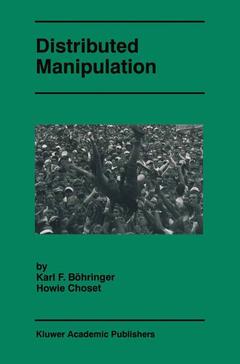Distributed Manipulation, Softcover reprint of the original 1st ed. 2000
Langue : Anglais
Coordonnateurs : Böhringer Karl F., Choset Howie

Distributed manipulation effects motion on objects through a large number of points of contact. The primary benefit of distributed manipulators is that many small inexpensive mechanisms can move and transport large heavy objects. In fact, each individual component is simple, but their combined effect is quite powerful. Furthermore, distributed manipulators are fault-tolerant because if one component breaks, the other components can compensate for the failure and the whole system can still perform its task. Finally, distributed manipulators can perform a variety of tasks in parallel.
Distributed manipulation can be performed by many types of mechanisms at different scales. Due to the recent advances of MEMS (micro-electro-mechanical system) technology, it has become feasible to quickly manufacture distributed micro-manipulators at low cost. One such system is an actuator array where hundreds of micro-scaled actuators transport and manipulate small objects that rest on them. Macroscopic versions of the actuator array have also been developed and analyzed. Another form of distributed manipulation is derived from a vibrating plate, and teams of mobile robots have been used to herd large objects into desired locations.
There are many fundamental issues involved in distributed manipulation. Since a distributed manipulator has many actuators, distributed control strategies must be considered to effectively manipulate objects. A basic understanding of contact analysis between the actuators and object must also be considered. When each actuator in the array has a sensor, distributed sensing presents some basic research challenges. Distributed computation and communication are key issues to enable the successful deployment of distributed manipulators into use. Finally, the trade-off in centralized and de-centralized approaches in all of these algorithms must be investigated.
Distributed manipulation can be performed by many types of mechanisms at different scales. Due to the recent advances of MEMS (micro-electro-mechanical system) technology, it has become feasible to quickly manufacture distributed micro-manipulators at low cost. One such system is an actuator array where hundreds of micro-scaled actuators transport and manipulate small objects that rest on them. Macroscopic versions of the actuator array have also been developed and analyzed. Another form of distributed manipulation is derived from a vibrating plate, and teams of mobile robots have been used to herd large objects into desired locations.
There are many fundamental issues involved in distributed manipulation. Since a distributed manipulator has many actuators, distributed control strategies must be considered to effectively manipulate objects. A basic understanding of contact analysis between the actuators and object must also be considered. When each actuator in the array has a sensor, distributed sensing presents some basic research challenges. Distributed computation and communication are key issues to enable the successful deployment of distributed manipulators into use. Finally, the trade-off in centralized and de-centralized approaches in all of these algorithms must be investigated.
A Distributed, Universal Device For Planar Parts Feeding: Unique Part Orientation in Programmable Force Fields.- Experiments in Constrained Prehensile Manipulation: Distributed Manipulation With Ropes.- Simultaneous Planar Transport of Multiple Objects on Individual Trajectories Using Friction Forces.- Hybrid Approach of Centralized Control and Distributed Control For Flexible Transfer System.- Autonomous Distributed System for Cooperative Micromanipulation.- Discreteness Issues in Actuator Arrays.- Design and Simulation of a Miniature Mobile Parts Feeder.- Building a Universal Planar Manipulator.- Distributed Agent Programming in the Architecture For Agile Assembly.- CMOS Integrated Organic Ciliary Actuator Arrays For General-Purpose Micromanipulation Tasks.- Distributed Actuation Devices Using Soft Gel Actuators.- Two Approaches to Distributed Manipulation.
Date de parution : 07-2013
Ouvrage de 261 p.
15.5x23.5 cm
Date de parution : 01-2000
Ouvrage de 261 p.
15.5x23.5 cm
Thème de Distributed Manipulation :
© 2024 LAVOISIER S.A.S.
